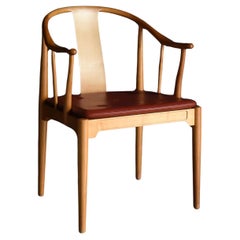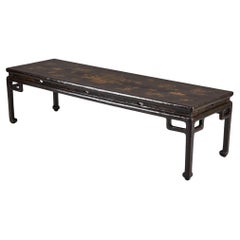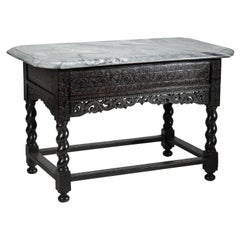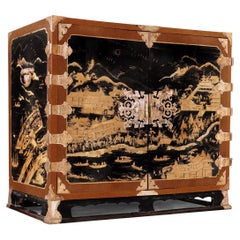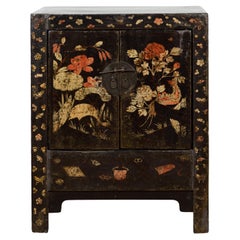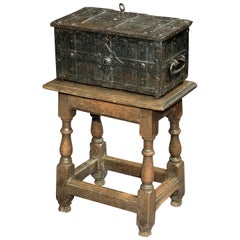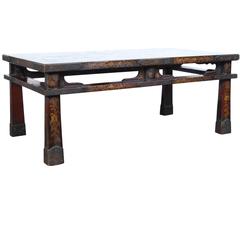Mid-17th Century Furniture
4
to
2
1
4
4
4
1
145
1,348
1,480
507
726
433
125
118
10
44
18
17
49
84
29
22
21
4
1
1
1
1
3
2
2
1
1
1
1
Period: Mid-17th Century
1950s Chinese Chair by Hans Wegner for Fritz Hansen
Located in Shibuya City, JP
The China Chair is the only pure wooden chair in Fritz Hansen's collection. It was inspired by the design of the "Quan Yi" chair from 18th century China and has been in production si...
Category
Danish Scandinavian Modern Antique Mid-17th Century Furniture
Materials
Leather, Mahogany, Teak
17th Century Chinese Table
Located in Hudson, NY
Chinese dry lacquer table with gold designs depicting floral arrangements and accoutrements.
Category
Chinese Antique Mid-17th Century Furniture
Materials
Gold
Dutch Colonial 17th Century Ebony Center Table with Marble Top
Located in Amsterdam, NL
An Indonesian ebony centre table with marble top
Jakarta (Batavia) or Coromandel coast, 1650-1680
With shallow carvings of flowers and vi...
Category
Indian Dutch Colonial Antique Mid-17th Century Furniture
Materials
Marble
Low Chinese Painted Book Cabinet, Ming Dynasty
Located in Chicago, IL
A rolled-up scroll or treasured root pot may have once been among the treasured objects stored in this 19th century book chest. Expertly constructed in China'...
Category
Chinese Ming Antique Mid-17th Century Furniture
Materials
Wood
Related Items
17th Century Japanese Export Lacquer Cabinet with Depiction the Dutch Tradepost
Located in Amsterdam, NL
A highly important Japanese export lacquer cabinet with depiction of the Dutch East India Company tradepost Deshima and the annual Dutch delegation on its way to the Shogun in Edo
Edo period, circa 1660-1680
H. 88 x W. 100.5 x D. 54 cm
This cabinet includes a later European japanned stand, but also a modern powder-coated steel frame.
The latter can be designed and added to your specific needs.
The sides and front of the rectangular two-door cabinet are embellished in gold and silver hiramaki-e and takamaki-e on a black roiro lacquer ground with a continuous design. The two doors depict a long procession of numerous figures travelling on foot and horseback along buildings and a pagoda into a mountainous landscape. This is the annual court journey, Hofreis, of the Dutch from Nagasaki to the Shogun’s court in Edo. Three horseback riders are dressed as Dutch merchants and a fourth figure, probably het Opperhoofd, is seen inside a palanquin, norimon. Just about to cross the bridge, two men are carrying a cabinet like the present one.
Many Japanese figures on either side of the procession are engaged in various activities; some play musical instruments on board of small boats, others are fishing; figures inside buildings are depicted playing go, and farmers are tending to their rice paddocks. The upper part of the right door shows a large mansion, probably the local daimyo’s castle, with men kneeling before a man in the central courtyard.
The court journey fits in with the foreign policy of the shogunate which accorded a role to the VOC alongside China, Korea, and the Ryukyu Islands who also had to pay tribute. However, the VOC employees were traders, having low status in Japan’s social hierarchy, and they were received with less deference than were the state embassies from Korea and the Ryukyu Islands. Nevertheless, the contacts with the Dutch were a welcome source of information to the Shogun about Europe and European science and technology.
The left side of the cabinet depicts, in mirror image, a rare view of the artificial fan-shaped Deshima Island, the trading post for the Dutch in Japan. The island, where the Dutch flag flies, is surrounded by small Japanese boats and an anchored three-masted fluyt (cargo ship), flying Dutch flags, with on the stern the VOC monogram. On the bottom right a busy street of Nagasaki is shown, bordered by shops and leading up to the stone bridge. On the island the trees are beautifully painted, two cows can be seen, and the flagpole, all in very fine detail. Dutchmen and enslaved Malay are visible outside the buildings and two Japanese figures, probably guards, sit in a small hut in the centre.
A maximum of fifteen to twenty Dutchmen lived on the island at any time and soldiers or women were not allowed. Restrictions on Deshima were tight, and the merchants were only allowed to leave the island by special permission. The Opperhoofd had to be replaced every year, and each new Opperhoofd had to make a court journey to pay tribute, present gifts, and to obtain permission to Margaret Barclay eep on trading. In the distance, many birds fly above the hills and a four-story pagoda can be seen. The right side of the cabinet is painted with other horse riders and their retinue journeying through mountains.
The pair of doors to the front open to reveal ten rectangular drawers. The drawers are decorated with scenes of birds in flight and landscapes with trees and plants. The reverse of the left door with two thatched buildings, one with a ladder, underneath a camelia tree with large blooms; the right door with a three-story pagoda nestled among trees and both doors with a flying phoenix, ho-oo bird. The cabinet, with elaborately engraved gilt copper mounts, hinges, lock plates and brass handles, is raised on an 18th-century English japanned wood stand.
A pair of large cabinets...
Category
Japanese Edo Antique Mid-17th Century Furniture
Materials
Copper, Gold
Free Shipping
H 34.65 in W 39.57 in D 21.26 in
Chinese Late Qing Dynasty Lacquered Bedside Cabinet with Hand Painted Décor
Located in Yonkers, NY
A Chinese late Qing Dynasty period dark brown lacquered bedside cabinet from the early 20th century, with hand painted cream and orange dragon, bird and floral motifs, two doors, traditional bronze medallion hardware, straight legs, carved apron and weathered patina. This Chinese late Qing Dynasty period dark brown lacquered bedside cabinet from the early 20th century is a captivating blend of artistry, history, and craftsmanship. The cabinet boasts a rich, dark brown lacquer finish, imbuing it with a sense of timeless elegance and sophistication. The exquisite hand-painted cream and orange dragon, bird, and floral motifs dance across the cabinet's surface, adding a layer of intrigue to this remarkable piece.
The cabinet features two doors, fitted with traditional bronze round medallion hardware that complements the dark lacquer and painted motifs. The doors open to reveal convenient storage space, perfect for housing books, personal items, or any other bedside essentials. The cabinet stands on four straight legs, providing a sturdy and balanced foundation, while the simply carved apron completes the ensemble beautifully.
A weathered patina graces the surface of this early 20th-century Chinese bedside...
Category
Chinese Qing Mid-17th Century Furniture
Materials
Bronze
H 33 in W 26 in D 17.5 in
Chinese Altar Table, 19th Century
Located in Doylestown, PA
A Chinese altar table in stained and lacquered elm with carved side decoration and two drawers with original hardware.
Category
Chinese Qing Antique Mid-17th Century Furniture
Materials
Elm
19th Century Cabinet, Ming style
Located in Kastrup, DK
Cabinet, Ming style made in jumo wood. From Suzhou China, located close to Shanghai. Was formerly the largest city in Jiangsù province. Each panel made of one piece of wood. "Jumu wo...
Category
Chinese Ming Antique Mid-17th Century Furniture
Materials
Metal
Chinese Ming-Style Tapered Cabinet with Original Red Lacquer
Located in Kastrup, DK
Mid-19th century Chinese tapered cabinet. Original red lacquer.
Pair of doors fitted with bronze lock opens to reveal a shelved interior, fitt...
Category
Chinese Ming Antique Mid-17th Century Furniture
Materials
Brass
Chinese Qing Dynasty Cabinet with Original Décor
Located in Kastrup, DK
Rare Qing dynasty cabinet with original well preserved decorations.
Red base lacquer with polychrome decorations, black lacquer on the sides.
Top...
Category
Chinese Qing Antique Mid-17th Century Furniture
Materials
Elm
Late 18th Century Chinese Low Table / Daybed
Located in Hoddesdon, GB
Chinese , Low Table / Daybed dating to the latter part of the 18th century .
Solid elm wood , generous proportions , traditional design, solid thick single plank top with cleated ends , mortise and tenon construction. Wonderful colour and amazing surface patination .
The clean lines used in Chinese antique furniture...
Category
Chinese Ming Antique Mid-17th Century Furniture
Materials
Elm
18th Century Chinese Table
Located in Rochester, NY
Antique 18th century Chinese Yumu ( northern elm wood ) table with early mortise tenon and mitered construction, floating skirted top and modified hoof fe...
Category
Chinese Qing Antique Mid-17th Century Furniture
Materials
Elm
20th Century Chinese Altar Table
Located in Southampton, NY
20th Century Chinese Altar Table
Scrolling cut out design along top rail of altar table. General wear, good overall condition.
18" deep x 60" wi...
Category
Chinese Mid-17th Century Furniture
Materials
Wood
Chinese Qing Dynasty 19th Century Cabinet with Hand-Painted Floral Décor
Located in Yonkers, NY
A Chinese Qing Dynasty period painted wood cabinet from the 19th century, with floral décor and brass hardware. Created in China during the 19th century, this painted cabinet feature...
Category
Chinese Qing Antique Mid-17th Century Furniture
Materials
Wood
Rare Charming 17th Century Japanese Lacquer Cabinet with Gilt-Bronze Mounts
Located in Amsterdam, NL
A fine Japanese pictoral style lacquer cabinet with gilt-metal mounts
Kyoto, Edo period, 1670-1690
Decorated in Japanese relief lacquer work, black lacquer ground decorated...
Category
Japanese Antique Mid-17th Century Furniture
Materials
Bronze
Free Shipping
H 23.82 in W 24.02 in D 18.31 in
1950s Solid Teak Side End Table by Hans C Andersen
Located in Victoria, BC
An exquisite solid teak end table, designed by the renowned Hans C Andersen in the 1950s, boasts a stunning display of unique old growth graining, captivating turned legs, and remain...
Category
Mid-Century Modern Vintage Mid-17th Century Furniture
Materials
Teak
Previously Available Items
Strongbox, Mid-17th Century, Baroque, Small, Iron, United
Located in BUNGAY, SUFFOLK
The top with four square and four narrow rectangular, panels reinforced with strap work and bolts. The central rectangular key plate lifts to reveal the keyhole. Nail holes on the un...
Category
German Baroque Antique Mid-17th Century Furniture
Materials
Iron
Japanese Buddhist Offering Table, circa 17th Century
Located in Prahran, Victoria
Rare Japanese red and black lacquered Buddhist offering table decorated with gilded floral and butterfly motifs and applied incised gilt copper hardware, early Edo circa 1650.
Dim...
Category
Japanese Edo Antique Mid-17th Century Furniture
Materials
Copper
Read More
Chicago’s Pagoda Red Has a Spirited Mix of Asian Antiques and Bold New Art
For 25 years, gallerist Betsy Nathan has leveraged her keen eye and key connections to bring a unique selection of rare finds to the market.
12 Calming Spaces Inspired by Japanese Design
From cherry-blossom-adorned walls paired with glamorous lighting to wood-paneled ceilings above checkerboard-patterned chairs, these 12 spaces seamlessly blend Eastern and Western aesthetics.
Recently Viewed
View AllMore Ways To Browse
Qing Dynasty Doors
Qing Dynasty Brass Furniture
19th Century Asian Chairs
Blue Chinese Lacquer Furniture
Antique Chinese Beads
Asian Red Lacquered Table
Chinese Plant Stands
Plant Stand China
Plant Stand Chinese
19th Century Chinese Calligraphy
Antique Asian Desk
Chinese Scroll Framed
Painted Chinese Cabinets
Antique Asian Sideboard
Antique Asian Altar Table
Chinese Wooden Panel
Asian Red Lacquer Gilt
Asian Black Chests
